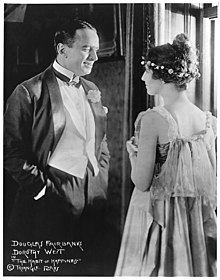Dorothy West (actress)


Dorothy West (August 29, 1891 – December 11, 1980) was an American actress in silent films and in radio.
She grew up in Huntsville, Alabama.[1]
West was a star in Biograph silent films in New York. She came to Hollywood with a group of D.W. Griffith stars that included Mary Pickford, Marion Leonard, Florence Barker, and Mack Sennett in 1909.[2][3] West, Pickford, Pickford's brother Jack, and Effie Johnson boarded together.[3]
She joined a stock theatre company in Mount Vernon, Illinois;[1] then joined the Pitt Stock Players in Pittsburgh, Pennsylvania;[4] and in also performed in theatre in Halifax, Nova Scotia.[1]
West returned to film several years later. West received positive notice for her work in Griffith's His Mother's Scarf (1911)[5] Swords and Hearts (1911)[6] and The Eternal Grind (1916).[7]
West left films again to tour in theatre productions in Europe after World War I with the American Army of Occupation[1], including in Germany.[8]
She also worked on Broadway[9] and with a theatre company called The Triangle Players.[10] She performed in the short play Sintram of Skaggerack by Sada Cowan in 1923.[11]
She made her radio debut in 1928.[1]
Selected filmography
- The Girl and the Outlaw (1908)
- The Guerrilla (1908)
- An Awful Moment (1908)
- One Touch of Nature (1909)
- Love Finds a Way (1909)
- Those Boys! (1909)
- The Girls and Daddy (1909)
- The Brahma Diamond (1909)
- His Wife's Mother (1909)
- The Roue's Heart (1909)
- I Did It (1909)
- The Deception (1909)
- A Burglar's Mistake (1909)
- The Day After (1909)
- The Unchanging Sea (1910)
- In the Border States (1910)
- The House with Closed Shutters (1910)[12]
- His Mother's Scarf (1911)
- Swords and Hearts (1911)
- The Habit of Happiness (1916)
- The Eternal Grind (1916)
References
- ^ a b c d e "From Alabam'". Burlington Hawk Eye October 28, 1928. October 28, 1928. p. 19. Retrieved April 21, 2020 – via NewspaperArchive.
{{cite news}}: CS1 maint: url-status (link) - ^ "Hollywood's 3d of a Century". Variety. Vol. 133, no. 4. January 4, 1939. p. 5 – via Proquest.
{{cite news}}: CS1 maint: url-status (link) - ^ a b Arvidson, Linda (1969) [1925]. When the movies were young. Dover Publications.
- ^ Zimmerman, M.K. (November 22, 1913). "Pittsburgh, PA". The Billboard. Vol. 25, no. 47. p. 18 – via Proquest.
{{cite news}}: CS1 maint: url-status (link) - ^ "Notable Attractions at the Picture House". The Syracuse Herald. April 2, 1916. Retrieved April 22, 2020 – via NewspaperArchive.
{{cite news}}: CS1 maint: url-status (link) - ^ Denig, Lynde (April 15, 1916). "Biograph Reissues for May: More Griffith Subjects with Casts That Mean Much to Followers of the Screen". The Moving Picture World. p. 457.
- ^ "Mary Pickford at Stanley". The Philadelphia Inquirer. April 11, 1916. p. 5. Retrieved April 22, 2020 – via NewspaperArchive.
{{cite news}}: CS1 maint: url-status (link) - ^ "Dramatic Stock: American Stock in Germany". The Billboard. Vol. 19, no. 32. May 8, 1920. p. 12 – via Proquest.
{{cite news}}: CS1 maint: url-status (link) - ^ "Fine Triangle Films". The Billboard. Vol. 28, no. 14. April 1, 1916. p. 58 – via Proquest.
{{cite news}}: CS1 maint: url-status (link) - ^ "Legitimate: Little Theatres". Variety. Vol. 70, no. 13. May 17, 1923. pp. 16, 33 – via Proquest.
{{cite news}}: CS1 maint: url-status (link) - ^ Gillette, Don Carle (May 19, 1923). "The Triangle Players". The Triangle Players. Vol. 35, no. 20. p. 10 – via Proquest.
{{cite news}}: CS1 maint: url-status (link) - ^ Keil, Charlie; Singer, Ben (2009). American Cinema of the 1910s: Themes and Variations. Rutgers University Press. ISBN 978-0-8135-4445-8.
External links
- Dorothy West at IMDb
